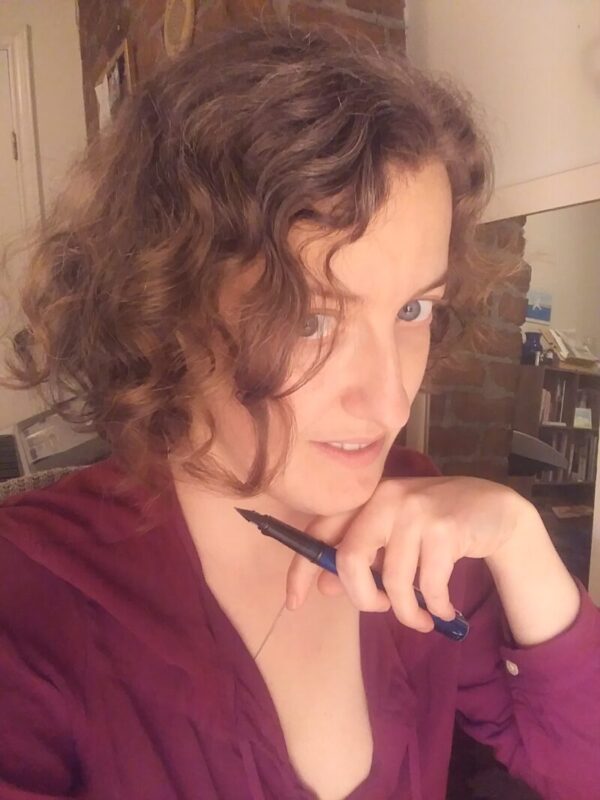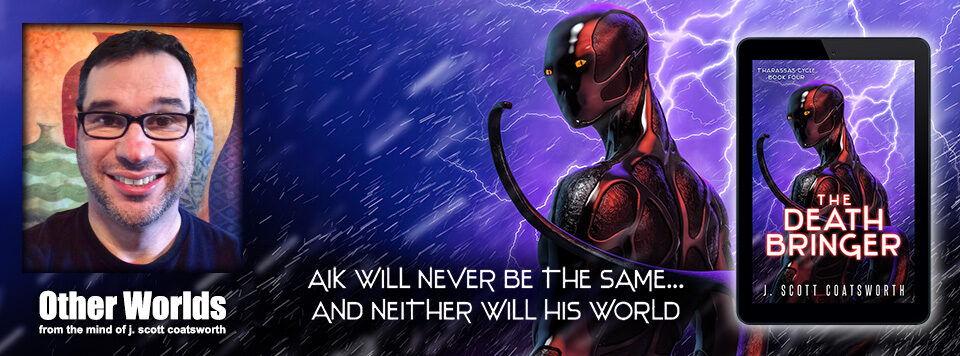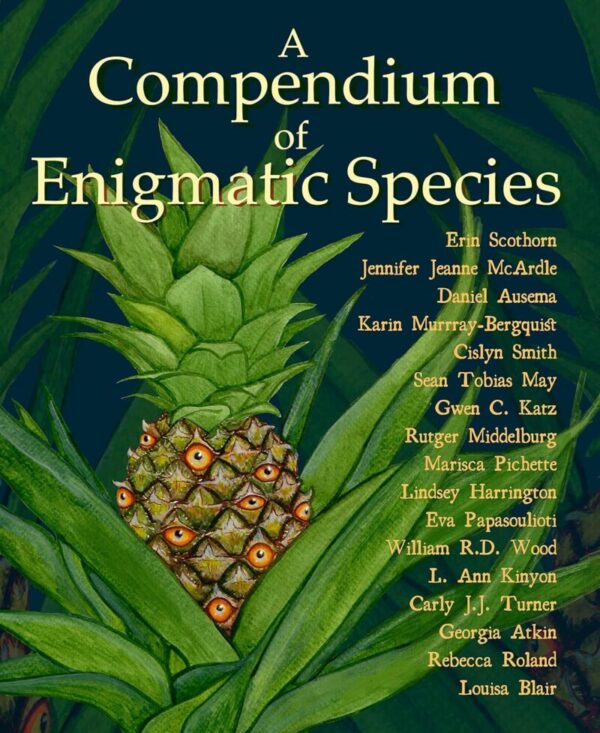
Welcome to my weekly Author Spotlight. I’ve asked a bunch of my author friends to answer a set of interview questions, and to share their latest work.
Today: Karin Murray-Bergquist is a writer, actor, artist, and PhD student in Folklore. Their work has appeared in Augur Magazine, Lighthouse Digest, Metapsychosis, Queer Sci-Fi anthologies, Engen Books’ anthology Acceptance: Stories at the Centre of Us, and Air and Nothingness Press anthologies.
Thanks so much, Karin, for joining me!
J. Scott Coatsworth: How would you describe your writing style/genre?
Karin Murray-Bergquist: Probably something like historical fantasy with a comic or gothic flavour! I tend to go for more of a humorous style when writing scripts, with the exception of the adaptation of Dracula: A Radio Play. I also occasionally write ghost stories so those tend to be more in the darkly atmospheric vein, rather contained, and focused on the sense of mystery and dread. My stories also tend to be character driven and have a definite sense of place, whether the place in question is real or otherwise.
JSC: Why did you choose to write in your particular field or genre? If you write more than one, how do you balance them?
KMB: Much of my fiction is comprised of the parts that didn’t quite fit in a research paper. I study folklore, and the trouble with folklore is that it inspires a person to make up their own tales, which isn’t exactly the way to approach an academic piece — excellent however for use in fiction. I write papers, stories, plays, poems, and sometimes parts of novels that have yet to be completed, so balance is tricky when trying to work on all of them at once, but they do assist each other by way of an idea that doesn’t quite work in prose getting thrown into a poem instead and vice versa. Sometimes the fiction aids the academia, so now due to writing the script for Dracula: A Radio Play I have enough material to write a pretty solid academic paper on the importance of sleep and sleeplessness in the original novel. Which, ironically, will probably cost me many more sleepless nights.
JSC: What’s the funniest or creepiest thing you’ve come across while researching for one of your stories?
KMB: When researching medieval Bretagne, for a comedy radio play, I came across the name of the Archbishop of Dol in 1107 — he was called Baldric. Baldric! Like Blackadder’s foolish sidekick! He probably had a cunning plan for every ecclesiastical problem. Fortunately for our characters he wasn’t around yet at the time our show took place. I had a good laugh at that, though there were weirder coincidences that haunted that production.
JSC: How did you choose the topic for A Compendium of Enigmatic Species?
KMB: This was an idea Mary Thaler, Erin Scothorn, and I came up with. We are all writers in the general speculative realm, and Mary is a scientist, so it was a way of combining our interest in the natural world with something a little magical, and we chose the parameters for our call for submissions based on what we envisioned for this combination. While we all enjoy stories set in fantasy worlds, we decided to limit this one to the planet we live on — wondrous things in a real setting was what we were going for with this anthology.
JSC: What were your goals and intentions in this book, and how well do you feel you achieved them?
KMB: We had as our goal to make this collection eclectic, imaginative, and intriguing, to bring readers from one intricately drawn world to the next, examining the question of nature, the supernatural, and the unknown from different angles. Since one of our core questions was “what does it mean for something to be known or described” we wanted to play with traditional academic structures of knowledge and authority, and one of my own intentions while writing was to magnify something humble into something tremendously significant, by way of the challenge of conveying it to other people. If something cannot be proven, how does the person witnessing it describe what they have found? How do they find others who are aware of its existence, without risking scorn and incredulity? That was what was in my mind while writing “Mistbloom,” and I tried to choose stories with a combination of narrative and description; I admit I had a preference for the scientific paper style of writing, but the personal stories of the strange and peculiar were also pleasing. I looked for stories that addressed the meaning that people assign to knowledge, whether utilitarian, symbolic, ecological, or otherwise.
JSC: Who did your cover, and what was the design process like?
KMB: The cover is by the fabulous Alison Kate Helmer, who does really brilliant watercolours of animals in old-fashioned clothes, and who selected the subject for the cover based on which story lent itself to illustration. She consulted with the author of the story, Erin Scothorn, and then the rest was up to her wonderful skills in terms of creating a design. There were a few adjustments with the text colour for the sake of visibility, and Alison was extremely easy to work with. She came up with a beautiful piece to catch the attention of anyone interested. It’s the first story in the book, too! Alison’s work can be found on Instagram and Facebook and I very much recommend checking it out.
JSC: What are some day jobs that you have held? If any of them impacted your writing, share an example.
KMB: I have worked in an archive, which definitely affected how documentation and record keeping play out. I also learned a lot of strange stories in the archive, some of which have made it into various pieces of my fiction, and if anyone in a story of mine ever complains about having to decipher bad handwriting, that’s straight from the vault. I occasionally write my own murder mystery games, and one of them was inspired by the security system someone told me about in an archive they had known. Working as a haunted tour guide also gave me a lot of thoughts on how people interact with the places they live, and made for some use of the hidden elements of cities. Much of the setting of “The Second,” which uses aurora-powered planes, was based on a job I had in Churchill.
JSC: What qualities do you and your characters share? How much are you like them, or how different are they from you?
KMB: I put aspects of myself into any character I write, so that however different we may be on the whole there is some part of them that I understand, whether it’s a fault or a helpful trait or something that could be both. Usually first-person narrators get my snarkier thoughts. I try not to overuse this one, though. Often, what we share are broad traits, such as insecurity, curiosity, impulsivity, earnestness, and interest or lack thereof in similar things. Then where we differ will be how those traits are paired with others, and what we do with them. A character who seeks out interesting plants might get my love of the outdoors, while another might have my shyness around crowds, but we’ll differ in other ways, and how self-aware they are about any of these qualities or defects will vary.
JSC: Do you have any strange writing habits or superstitions?
KMB: When I wrote an academic paper on supernatural creatures who traditionally prefer not to be talked about, I included an explanation of this trait and noted my apologies. Less of a superstition than a mark of respect towards those beings, but it only occurred to me once I was writing the paper that they might be displeased!
JSC: What are you working on now, and what’s coming out next? Tell us about it!
KMB: The theatre company, Pourquoi-Pas? Players, is planning a queer, academic version of Pride and Prejudice in June 2024. Along with acting in it I’m writing the script. It’s long been a theory of mine that Austen would translate beautifully to a slightly modernised academic setting due to the questions of power, respectability, financial trouble, and critical thinking that fill her work. The characters are so vivid, and I’ve definitely met some of them in the hallowed halls!
And now for Karin’s latest release, the short story “Mistbloom (Globula glymuria)”, in the A Compendium of Enigmatic Species sci-fi/fantasy anthology:
What’s it like to be the first one to discover a new species, to see life take a form that no one else has ever seen before? In this anthology of innovative speculative writing and art, 18 contributors capture the moment of discovery and awe when we encounter a new species. By turns humorous, horrific, and awe-inspiring, their work invites you to turn a scientist’s eye on the the world of the fantastical.
Amazon | Barnes & Noble | Kobo
Excerpt
Taxonomy: It ought to belong to the kingdom Plantae, though its very nature makes classification difficult: at first, we supposed it was a globule of water cradled by the leaves, as is sometimes seen, yet it seems to be a form of symbiosis between plant and mist, that has evolved into a living organism.

